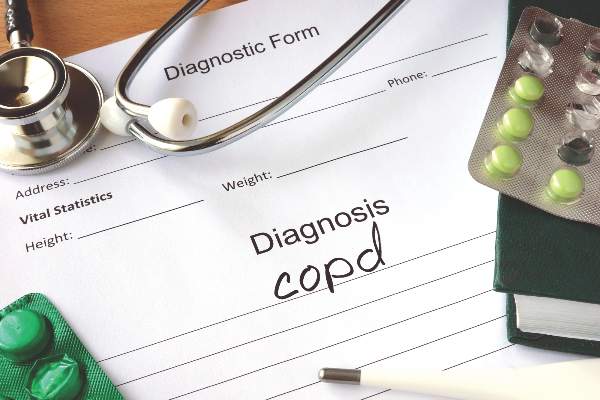User login
A once-daily inhaled combination of fluticasone furoate and vilanterol was associated with an 8% lower rate of exacerbations in chronic obstructive pulmonary disease (COPD) than was usual care, with no increase in adverse effects, according to a multicenter trial designed to reflect real-world practice.
“Future effectiveness studies [like this one] are likely to influence clinical guidelines, not only for COPD but [also] for many other chronic diseases,” said Jørgen Vestbo, MD, of University Hospital of South Manchester NHS Foundation Trust, Manchester, England, and his associates, for the Salford Lung Study investigators. The findings were presented at the annual congress of the European Respiratory Society and published simultaneously in the New England Journal of Medicine.
Current COPD guidelines are based on clinical trials of carefully selected and monitored patients, which substantially limits their usefulness in everyday practice, the researchers said. To help address that problem, their 12-month, prospective, open-label, parallel-group, randomized study enrolled 2,799 COPD patients in 75 general practices within a single urban area in the United Kingdom. Patients received 100 mcg of fluticasone furoate and 25 mcg of vilanterol or usual care. The primary outcome was the rate of moderate or severe exacerbations among patients who had experienced an exacerbation within 1 year before enrollment. Patients received all treatment from their usual providers and were monitored remotely for safety through electronic health records (N Engl J Med. 2016 Sep 4. doi: 10.1056/NEJMoa1608033).
Fluticasone furoate/vilanterol was associated with 1.74 moderate or severe exacerbations per year, compared with 1.9 events per year with usual-care group, for a statistically significant difference of 8.4% (95% confidence interval, 1.1%-15.2%; P = .02). The trial arms had similar rates of COPD-related health care visits and first moderate or severe exacerbations. They also did not notably differ in terms of serious adverse events of special interest, such as cardiovascular events (which affected 8% of patients in each group) or pneumonia (which affected 7% of fluticasone furoate/vilanterol patients and 6% of usual-care patients). Thirteen patients in each group developed fatal pneumonia, of which one case was considered related to usual care. The only other treatment-related death involved of deep-vein thrombosis and pulmonary embolism in a patient receiving fluticasone furoate/vilanterol.
Medication switches were about twice as common (22%) in the intervention group than in the usual care group (11%), perhaps because of the open-label nature of the trial, the researchers said. Only 4% of patients receiving fluticasone furoate/vilanterol needed better disease control, half the rate of the usual care group.
GlaxoSmithKline funded the trial. Dr. Vestbo reported personal fees from GlaxoSmithKline while the study was conducted.
A once-daily inhaled combination of fluticasone furoate and vilanterol was associated with an 8% lower rate of exacerbations in chronic obstructive pulmonary disease (COPD) than was usual care, with no increase in adverse effects, according to a multicenter trial designed to reflect real-world practice.
“Future effectiveness studies [like this one] are likely to influence clinical guidelines, not only for COPD but [also] for many other chronic diseases,” said Jørgen Vestbo, MD, of University Hospital of South Manchester NHS Foundation Trust, Manchester, England, and his associates, for the Salford Lung Study investigators. The findings were presented at the annual congress of the European Respiratory Society and published simultaneously in the New England Journal of Medicine.
Current COPD guidelines are based on clinical trials of carefully selected and monitored patients, which substantially limits their usefulness in everyday practice, the researchers said. To help address that problem, their 12-month, prospective, open-label, parallel-group, randomized study enrolled 2,799 COPD patients in 75 general practices within a single urban area in the United Kingdom. Patients received 100 mcg of fluticasone furoate and 25 mcg of vilanterol or usual care. The primary outcome was the rate of moderate or severe exacerbations among patients who had experienced an exacerbation within 1 year before enrollment. Patients received all treatment from their usual providers and were monitored remotely for safety through electronic health records (N Engl J Med. 2016 Sep 4. doi: 10.1056/NEJMoa1608033).
Fluticasone furoate/vilanterol was associated with 1.74 moderate or severe exacerbations per year, compared with 1.9 events per year with usual-care group, for a statistically significant difference of 8.4% (95% confidence interval, 1.1%-15.2%; P = .02). The trial arms had similar rates of COPD-related health care visits and first moderate or severe exacerbations. They also did not notably differ in terms of serious adverse events of special interest, such as cardiovascular events (which affected 8% of patients in each group) or pneumonia (which affected 7% of fluticasone furoate/vilanterol patients and 6% of usual-care patients). Thirteen patients in each group developed fatal pneumonia, of which one case was considered related to usual care. The only other treatment-related death involved of deep-vein thrombosis and pulmonary embolism in a patient receiving fluticasone furoate/vilanterol.
Medication switches were about twice as common (22%) in the intervention group than in the usual care group (11%), perhaps because of the open-label nature of the trial, the researchers said. Only 4% of patients receiving fluticasone furoate/vilanterol needed better disease control, half the rate of the usual care group.
GlaxoSmithKline funded the trial. Dr. Vestbo reported personal fees from GlaxoSmithKline while the study was conducted.
A once-daily inhaled combination of fluticasone furoate and vilanterol was associated with an 8% lower rate of exacerbations in chronic obstructive pulmonary disease (COPD) than was usual care, with no increase in adverse effects, according to a multicenter trial designed to reflect real-world practice.
“Future effectiveness studies [like this one] are likely to influence clinical guidelines, not only for COPD but [also] for many other chronic diseases,” said Jørgen Vestbo, MD, of University Hospital of South Manchester NHS Foundation Trust, Manchester, England, and his associates, for the Salford Lung Study investigators. The findings were presented at the annual congress of the European Respiratory Society and published simultaneously in the New England Journal of Medicine.
Current COPD guidelines are based on clinical trials of carefully selected and monitored patients, which substantially limits their usefulness in everyday practice, the researchers said. To help address that problem, their 12-month, prospective, open-label, parallel-group, randomized study enrolled 2,799 COPD patients in 75 general practices within a single urban area in the United Kingdom. Patients received 100 mcg of fluticasone furoate and 25 mcg of vilanterol or usual care. The primary outcome was the rate of moderate or severe exacerbations among patients who had experienced an exacerbation within 1 year before enrollment. Patients received all treatment from their usual providers and were monitored remotely for safety through electronic health records (N Engl J Med. 2016 Sep 4. doi: 10.1056/NEJMoa1608033).
Fluticasone furoate/vilanterol was associated with 1.74 moderate or severe exacerbations per year, compared with 1.9 events per year with usual-care group, for a statistically significant difference of 8.4% (95% confidence interval, 1.1%-15.2%; P = .02). The trial arms had similar rates of COPD-related health care visits and first moderate or severe exacerbations. They also did not notably differ in terms of serious adverse events of special interest, such as cardiovascular events (which affected 8% of patients in each group) or pneumonia (which affected 7% of fluticasone furoate/vilanterol patients and 6% of usual-care patients). Thirteen patients in each group developed fatal pneumonia, of which one case was considered related to usual care. The only other treatment-related death involved of deep-vein thrombosis and pulmonary embolism in a patient receiving fluticasone furoate/vilanterol.
Medication switches were about twice as common (22%) in the intervention group than in the usual care group (11%), perhaps because of the open-label nature of the trial, the researchers said. Only 4% of patients receiving fluticasone furoate/vilanterol needed better disease control, half the rate of the usual care group.
GlaxoSmithKline funded the trial. Dr. Vestbo reported personal fees from GlaxoSmithKline while the study was conducted.
FROM ERS 2016
Key clinical point: A once-daily inhaled combination of fluticasone furoate and vilanterol was associated with statistically fewer COPD exacerbations compared with usual care in a real-world trial.
Major finding: The rate of moderate or severe exacerbations was 8% lower with fluticasone furoate/vilanterol group, compared with usual care (P = .02).
Data source: A 12-month, prospective, randomized open-label study of 2,799 COPD patients seen in general urban practices.
Disclosures: GlaxoSmithKline funded the trial. Dr. Vestbo reported personal fees from GlaxoSmithKline while the study was conducted.

